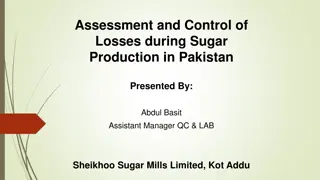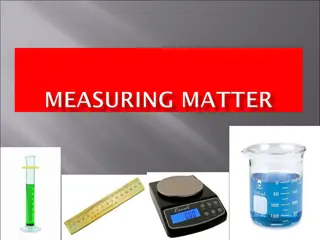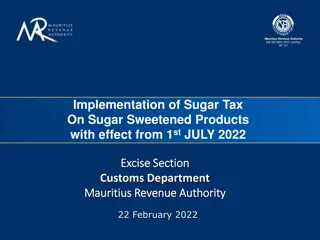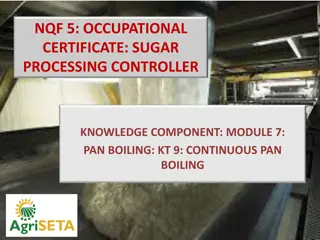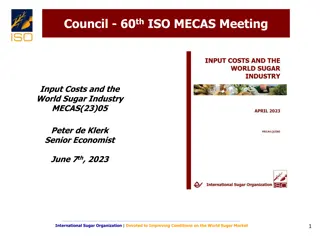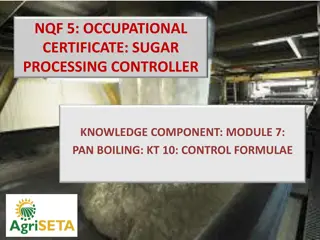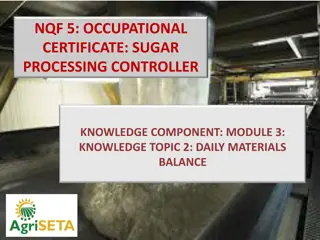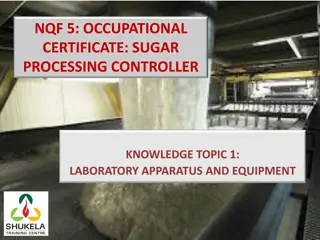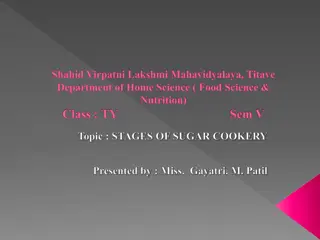Understanding Mass Measurement and Balances in Sugar Processing
The knowledge topic discusses the use of balances in sugar processing to measure mass accurately. It explains the difference between weight and mass, the units of mass, and the types of balances used in laboratories. From traditional mechanical balances to modern electronic balances, each plays a crucial role in ensuring precise measurements. Precautions when using a balance are highlighted to maintain accuracy in sugar processing operations.
Download Presentation

Please find below an Image/Link to download the presentation.
The content on the website is provided AS IS for your information and personal use only. It may not be sold, licensed, or shared on other websites without obtaining consent from the author. Download presentation by click this link. If you encounter any issues during the download, it is possible that the publisher has removed the file from their server.
E N D
Presentation Transcript
NQF 5: OCCUPATIONAL CERTIFICATE: SUGAR PROCESSING CONTROLLER KNOWLEDGE TOPIC 6: USE A BALANCE
INTRODUCTION The standard unit of mass is the kilogram, this unit is however, too big for use in the laboratory and we thus use the gram as the unit of mass. 1 kilogram = 1 000 grams (1 000 g = 1 kg) 1 gram = 1 000 milligrams (1 000 mg = 1 g) Weight and mass are not the same. Weight is the force exerted on an object by the earth (measured in Newtons). The mass of an object is a measure of the quantity of matter in the object. Mass is measured by comparison with known standard masses. A balance may mass to the nearest gram, to one, two, three or four decimal places.
A Balance In the laboratory mass is measured on a balance where the unknown mass is balanced against a known mass. This can be done with varying degrees of accuracy depending on the type of balance being used. The principle of a balance is a rigid beam which is supported and pivoted at the centre on a knife edge. Suspended from each end is a pan. One pan is used to hold the object being massed and the other holds the known standard mass. When the standards equal the unknown mass the beam is in equilibrium and the unknown mass can now be compared (equalled) to the standard mass. With modern balances the design is different but the principle remains the same.
Modern Mechanical Balances Externally these balances appear to have only one pan. However, the second pan is actually a set of masses inside the machine. Mettler Classic Analytical Balance (Model ML104T/00) Mettler Analytical Balance (Model H54AR)
Modern Electronic Balances Here the pan is connected to a bar placed in a solenoid (coil). The sample placed on the pan pushes the bar into the solenoid. The electronic controls of the balance then apply an electric current to the solenoid just enough to cause the bar to move back to its original position. The greater the mass of the sample, the greater the current required. The instrument is then calibrated so that this current is converted and displayed as a mass in grams. Principle of how an electronic balance works
PRECAUTIONS TO BE OBSERVED WHEN USING A BALANCE The balance must be positioned in a permanent place on a firm foundation as free as possible from vibration. Specially constructed tables are usually used. The balance must be shielded from draughts and from heat. The balance must be level. If the balance must be moved it must be done by a competent person. The balance must be clean. All spillages must be cleaned up immediately. Powder spillages must be swept immediately. Liquor spillages must be wiped up at once. A damp cloth must be used to wipe the spill and then the balance must be dried well.
PRECAUTIONS TO BE OBSERVED WHEN USING A BALANCE (Cont.) The maximum load of the balance (capacity) must be checked. This is stated on the balance and must not be exceeded under any circumstances. Check that the accuracy required by the analysis is available from the balance being used. Check the zero position of the balance and if necessary reset. N.B. The levelling and resetting are the only adjustments that a laboratory worker may make to the balance. If anything else is found to be wrong, it must be reported to the supervisor. The balance must always be used according to the manufacturer s instructions. All movement of dials and the addition and removal of objects must be done gently.
PRECAUTIONS TO BE OBSERVED WHEN USING A BALANCE (Cont.) The object to be massed must be at the same temperature as the balance. Warm objects in the balance cause air currents which render the massing inaccurate. Unequal expansion of the beam will introduce errors. Powders and liquids must be massed in suitable containers. Desiccants must not be placed in the balance as the air inside and outside the case should be in equilibrium. After massing the balance must be reset. All the dials must be set to zero. All traces of spillages and all vessels must be removed from the balance. The doors of the balance must be closed after use (if applicable).
MASSING AN OBJECT: Using a Modern Mechanical Analytical Balance (Sauter analytical balance) Zero the display using the adjustment knobs. Move the right hand side control level to the Full massing position and check that the scale reads zero. If the scale does not read exactly zero, reset it using the adjustment screw situated at the back right hand side of the balance. Move the right hand control lever to the full arrest position. Open the door, place the object on the pan and close the door. Move the right hand control lever to the approximate massing position Read the mass (say 7g). Move the right hand control lever to the full arrest position . Dial in 7g using the display knobs. Move the right hand side control lever to the full massing position . Adjust using the fine adjustment knob until the correct reading is obtained (i.e. the scale is lined up with the special mark). Adjust the right hand control lever to the full arrest position , remove the object / sample and return all display settings to zero.
MASSING AN OBJECT: Modern Electronic Analytical Balance Zero the scale by pressing the reset button / bar. Place the object on the pan, close the doors and wait for a steady reading. Take the reading. Remove the object and zero the instrument. Close the doors.
MASSING OUT A SPECIFIC AMOUNT OF SAMPLE Modern Mechanical Analytical Balance Part A: Massing the nickel basin The procedure is as described in section 1.6.4.1. Let us assume that the mass of the nickel massing basin was found to be 34.5573 g. Part B: Massing out a specific amount of sample (say 26.000g to 0.002g of sugar) (a) With the right hand control lever in the full arrest position dial in 60, _ _73 (34,5573g + 26,0000g = 60,5573g) on the display. (b) Switch to the Approximate Massing position and add almost 26g of sugar i.e. until the scale reads 60g. (c) Switch to full arrest position. Close the doors of the balance.
MASSING OUT A SPECIFIC AMOUNT OF SAMPLE (d) Move the lever into the full massing position and read the actual mass. Add or remove sample until the desired mass is obtained. Do not add or remove sample in the full massing position . When adding / removing sugar first switch to the approximate massing position. Then switch back to the full massing position to check if the correct amount of sugar has been added. Note: Since the mass of the sugar only needs to be within 0,002g, one can stop adding sugar when the scale reads 60,5555g since this is within 0,002g of 60,5573g. When the scale reading is very close to 60,5573g the right hand adjustment can be used to line up the mark (balance the scale) and hence find the exact mass.
MASSING OUT A SPECIFIC AMOUNT OF SAMPLE Modern Electronic Analytical Balance (a) Place the nickel massing basin on the pan and wait for a steady reading. (b) Tare the scale by pressing the reset button / bar. This will zero the scale. The scale stores the mass of the massing basin and displays it as zero. (c) Add sugar until the scale reads 26,0000g. (d) Remove the nickel massing basin and zero the instrument. Note: When doing moisture analyses this tare facility cannot be utilised, since the following information is required. Mass of empty dish Mass of dish and sample Mass of dish and dried sample.







